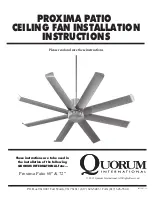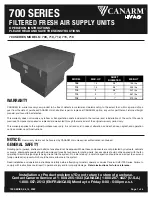
FAN WILL NOT START
1.
Check that the electricity has been
turned on at the circuit breaker which had
probably been turned off during
installation.
2.
Turn off the electricity. Check all
connections in the wiring of the fan at the
ceiling and make sure it follows the
wiring instructions outlined in this
manual.
3.
Be sure ON/OFF power switch on the
wall control is in ON position.
NOISE
Note:
Always allow a day or two "run-in"
time for any new fan at medium or high
speed. When attempting to diagnose
noise, listen carefully from several sides
to try and isolate the location of the noise
(blade, upper end, motor, light kit, etc.)
1.
Tighten all screws attaching blades to
blade arms. Remember to tighten these
screws at least once a year because they
may loosen slowly over time and cause a
clicking noise.
2.
Turn off the power. Loosen the
canopy and check that the wiring and/or
wire nut connectors are not resting against
the canopy, possibly vibrating while the
fan is on.
3.
Use of a standard light rheostat or an
unapproved fan wall control to control the
fan speed will always cause an annoying
"hum". Many fan motors do not work
quietly with solid state variable speed
controls.
4.
Check that the rubber gasket on the
mounting bracket has been installed if
called for in the installation instructions.
5.
Check that the canopy in not touching
the ceiling.
6.
Check that all screws on the motor
housing and the bottom housing are tight.
FAN TURNS, BUT DOES NOT MOVE
MUCH AIR
1.
The fan may be running in reverse.
Press the reverse button on transmitter to
set the fan in forward operation.
2.
The distance from the ceiling to the
blades may be too small. For downrod
fans, optimal placement would be 8-9 feet
from the floor.
3.
The room may contain items which
obstruct the air flow.
4.
The fan may be too small for the size
of the room.
EXCESSIVE WOBBLE
Note:
A small amount of wobble is
considered acceptable and should not be
considered a defect.
1.
Make certain all blades are tightly
attached to each blades' respective blade
arm.
10. TROUBLESHOOTING
REPLACEMENT PARTS AVAILABLE
A full range of genuine replacement
spare parts are available at reasonable
cost directly form Quorum
International. Please call us at (817)
626-5483. Monday through Friday
from 8:00 A.M. to 5:00 P.M. CST.




























